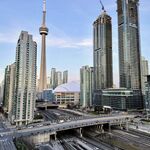rfid
New Member
I think a big problem in Toronto is we are still stuck believing that line = route. I think we need to eliminate that gridlock mentality to come up with more creative solutions to our transportation problems.
Roads are infrastructure. So is rail. Buses run on roads. Rail vehicles run on rail. We build roads incrementally, why can't we build rail incrementally too?
I commute from Scarborough to Mississauga (by 401). It was discussed in the Sheppard Subway Expansion thread that most people don't travel end-to-end on a line. One possible solution is express service.
Another consequence of believing line = route is that we build fairly linear along existing streets as demand warrants. We end up with proposals that do not provide meaningful cross-town connections or route service along corridors that make little sense to the average public.
What we need to do is connect major nodes in a hierarchy. Currently, GO train services runs to Union Station. What happened to the proposed cross-town? Two-way, all-day service is still a distance away.
Other cities have some form of hierarchy. Paris has RER trains combined with subways. New York City has regional rail, express subway service, and local service.
Similarly, our highway system isn't designed within the urban centres around hierarchy. US interstate and Quebec autoroute system have auxiliary routes that serve the area surrounding a node.
Ideally, I imagine Toronto as a region comprised of major nodes, connected by regional rail and highways, with the nodes themselves served by subways, LRTs, BRTs, arterial roads, and so forth. Depending on proximity to the node, you may traverse one less step of the hierarchy.
One day I may embark on an LRT to get to a GO train station. From there, I'll take the GO train to Mississauga, where I'll get off and take a BRT to steps from my office, where I'll have a nice, healthy walk to the front door. It will be competitive with the 35 minutes it takes in the best of times driving on the 401.
What happened to smart growth?
Roads are infrastructure. So is rail. Buses run on roads. Rail vehicles run on rail. We build roads incrementally, why can't we build rail incrementally too?
I commute from Scarborough to Mississauga (by 401). It was discussed in the Sheppard Subway Expansion thread that most people don't travel end-to-end on a line. One possible solution is express service.
Another consequence of believing line = route is that we build fairly linear along existing streets as demand warrants. We end up with proposals that do not provide meaningful cross-town connections or route service along corridors that make little sense to the average public.
What we need to do is connect major nodes in a hierarchy. Currently, GO train services runs to Union Station. What happened to the proposed cross-town? Two-way, all-day service is still a distance away.
Other cities have some form of hierarchy. Paris has RER trains combined with subways. New York City has regional rail, express subway service, and local service.
Similarly, our highway system isn't designed within the urban centres around hierarchy. US interstate and Quebec autoroute system have auxiliary routes that serve the area surrounding a node.
Ideally, I imagine Toronto as a region comprised of major nodes, connected by regional rail and highways, with the nodes themselves served by subways, LRTs, BRTs, arterial roads, and so forth. Depending on proximity to the node, you may traverse one less step of the hierarchy.
One day I may embark on an LRT to get to a GO train station. From there, I'll take the GO train to Mississauga, where I'll get off and take a BRT to steps from my office, where I'll have a nice, healthy walk to the front door. It will be competitive with the 35 minutes it takes in the best of times driving on the 401.
What happened to smart growth?




